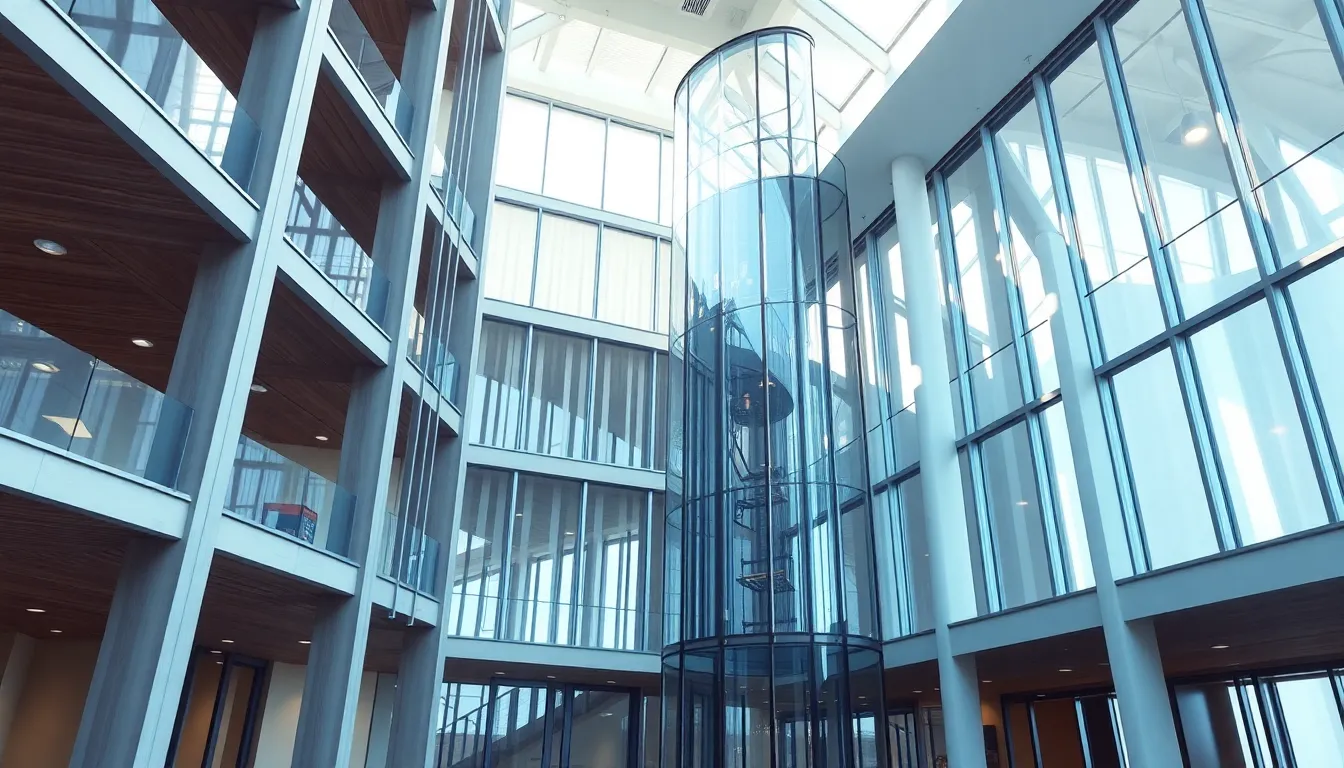Table of Contents
ToggleIn a world where air conditioning can feel like a luxury and energy bills can send shivers down anyone’s spine, natural ventilation design emerges as the superhero of sustainable architecture. Imagine a building that breathes as naturally as you do, harnessing the power of fresh air without a hefty price tag. It’s not just a dream—it’s a smart choice for those who want to keep their spaces cool and their wallets happy.
Overview of Natural Ventilation Design
Natural ventilation design leverages wind patterns and temperature differences to enhance indoor air quality. This design method eliminates reliance on mechanical systems, promoting sustainability in architecture. Various strategies exist for effective implementation.
Stack ventilation utilizes warm air rising, creating a pressure difference that pulls in cooler air from lower areas. Cross ventilation involves positioning openings on opposite sides of a space to allow fresh air flow through. These techniques minimize energy consumption, reducing both costs and environmental impact.
Building orientation significantly influences natural ventilation effectiveness. Properly aligned structures capture prevailing winds, optimizing air circulation. Incorporating thermal mass through materials helps maintain comfortable temperatures by absorbing and releasing heat as needed.
Designers often incorporate overhangs and operable windows to enhance user control over airflow. The use of openings in strategic locations maximizes airflow while providing occupants with comfort. Additionally, integrating passive solar design further enhances the benefits of natural ventilation.
Research supports the effectiveness of natural ventilation in improving indoor environments. Studies indicate that spaces designed with this principle maintain lower temperatures compared to those reliant on air conditioning systems. This results in higher occupant satisfaction and productivity, showcasing its importance in modern architecture.
Careful planning during the design phase ensures natural ventilation’s success. A thorough understanding of the site’s climate and environmental conditions is crucial. Through thoughtful consideration of these elements, architects can create spaces that effectively utilize natural ventilation, offering a sustainable and economically viable solution.
Principles of Natural Ventilation
Natural ventilation design utilizes principles that enhance indoor air quality and comfort through the natural movement of air. Effective strategies harness the elements of thermal dynamics and environmental forces.
The Stack Effect
The stack effect capitalizes on temperature differences within a building. Warm air naturally rises, creating a pressure difference that encourages cooler air to enter from lower openings. This method is particularly effective in multi-story buildings where hot air may accumulate indoors. Architects often design vertical shafts or openings to optimize this phenomenon. For instance, a building with high ceilings may amplify the stack effect, enhancing airflow. Utilizing this principle results in a comfortable indoor climate without mechanical systems.
The Wind Effect
The wind effect relies on outdoor wind patterns to facilitate air movement through a building. Strategically placed openings allow wind to enter from one side and exit from another, promoting cross ventilation. Research shows optimal building orientation increases effectiveness by aligning with prevailing winds. By incorporating adjustable windows or louvres, occupants can control airflow according to their preferences. Utilizing this natural force can significantly reduce indoor temperatures and improve air quality.
Benefits of Natural Ventilation Design
Natural ventilation design offers significant advantages in energy savings and indoor air quality. Incorporating this approach enhances comfort while reducing operational costs.
Energy Efficiency
Natural ventilation systems significantly lower energy consumption. By relying on passive cooling strategies, buildings can decrease their dependence on mechanical cooling systems. Research shows that utilizing cross ventilation can reduce energy costs by up to 40%. Optimizing window placement and building orientation maximizes airflow, which leads to less reliance on air conditioning. It’s essential to integrate design elements that facilitate natural airflow, such as larger windows and open spaces. Practitioners often find that thoughtful design enhances energy efficiency, creating a more sustainable building environment.
Improved Indoor Air Quality
Natural ventilation significantly enhances indoor air quality. By promoting fresh air circulation, buildings reduce pollutants and allergens inside a space. Reports indicate that naturally ventilated areas often have less moisture, reducing mold growth and improving occupant health. Proper ventilation strategies encourage the exchange of stale indoor air with clean outdoor air, leading to a more comfortable atmosphere. Positioning windows and openings to harness wind patterns facilitates this process. Architects recognize that designs prioritizing natural airflow can lead to healthier living environments, enhancing overall occupant well-being.
Strategies for Implementing Natural Ventilation Design
Natural ventilation design employs various strategies to optimize indoor air quality and enhance comfort. Effective implementation relies on thoughtful planning and consideration of site-specific conditions.
Building Orientation
Building orientation significantly influences natural ventilation effectiveness. Aligning structures with prevailing wind directions can maximize airflow through openings. For instance, positioning longer walls to face the wind allows for increased pressure differentials, fostering better air exchange. Several studies reveal that optimizing orientation leads to reduced energy consumption and improved indoor climates. Additionally, shading devices can be integrated to mitigate heat gain, enhancing the overall effectiveness of natural ventilation strategies.
Window Placement and Type
Window placement and type play crucial roles in facilitating natural ventilation. Strategic positioning of operable windows across different building facades can promote cross ventilation, ensuring fresh air circulates throughout the space. For example, larger windows on the windward side expedite air movement while smaller ones on the leeward side help exhaust stale air. Selecting appropriate window types, such as casement or sliding windows, can maximize usability and effectiveness. Utilizing high-performance glazing can further enhance energy efficiency and comfort levels inside.
Challenges in Natural Ventilation Design
Natural ventilation design presents various challenges that require careful consideration for successful implementation. Factors like climate and noise pollution significantly impact its effectiveness.
Climate Considerations
Climate plays a crucial role in determining the success of natural ventilation systems. Variability in temperature and humidity affects how air moves through a building. In hotter, humid climates, the risk of overheating increases due to limited airflow. Dedicated design strategies become essential to address these conditions. For example, incorporating overhangs can provide shade and minimize direct sunlight exposure. A thorough analysis of local weather patterns helps identify optimal openings for airflow, ensuring air circulation remains effective year-round. It’s important to consider seasonal changes as well because they influence ventilation needs. Through climate-responsive design, architects can optimize the benefits of natural ventilation without compromising indoor comfort.
Noise Pollution
Noise pollution poses another challenge for natural ventilation design. Excessive external noise can negatively affect occupants’ comfort and well-being. Busy streets and high-traffic areas often increase sound infiltration through open windows and ventilation openings. Implementing sound-insulating materials, like double-glazed windows, mitigates this issue. Strategic placement of openings assists in reducing noise transfer while maximizing airflow. Vegetation and landscape features can also act as natural sound barriers, enhancing indoor acoustics. Addressing noise impacts effectively ensures that natural ventilation systems provide both fresh air and a peaceful environment. By prioritizing noise control measures, architects create spaces that balance ventilation efficiency and occupant satisfaction.
Conclusion
Natural ventilation design stands out as a vital component of sustainable architecture. By harnessing natural air flow architects can create healthier indoor environments that enhance occupant comfort and satisfaction. This approach not only reduces energy costs but also promotes better air quality by allowing fresh air to circulate freely.
Effective implementation relies on thoughtful design choices such as strategic window placement and building orientation. Addressing challenges like climate and noise pollution is essential for maximizing the benefits of natural ventilation. With careful planning and a deep understanding of local conditions architects can successfully integrate natural ventilation into their designs, paving the way for a more sustainable future.





